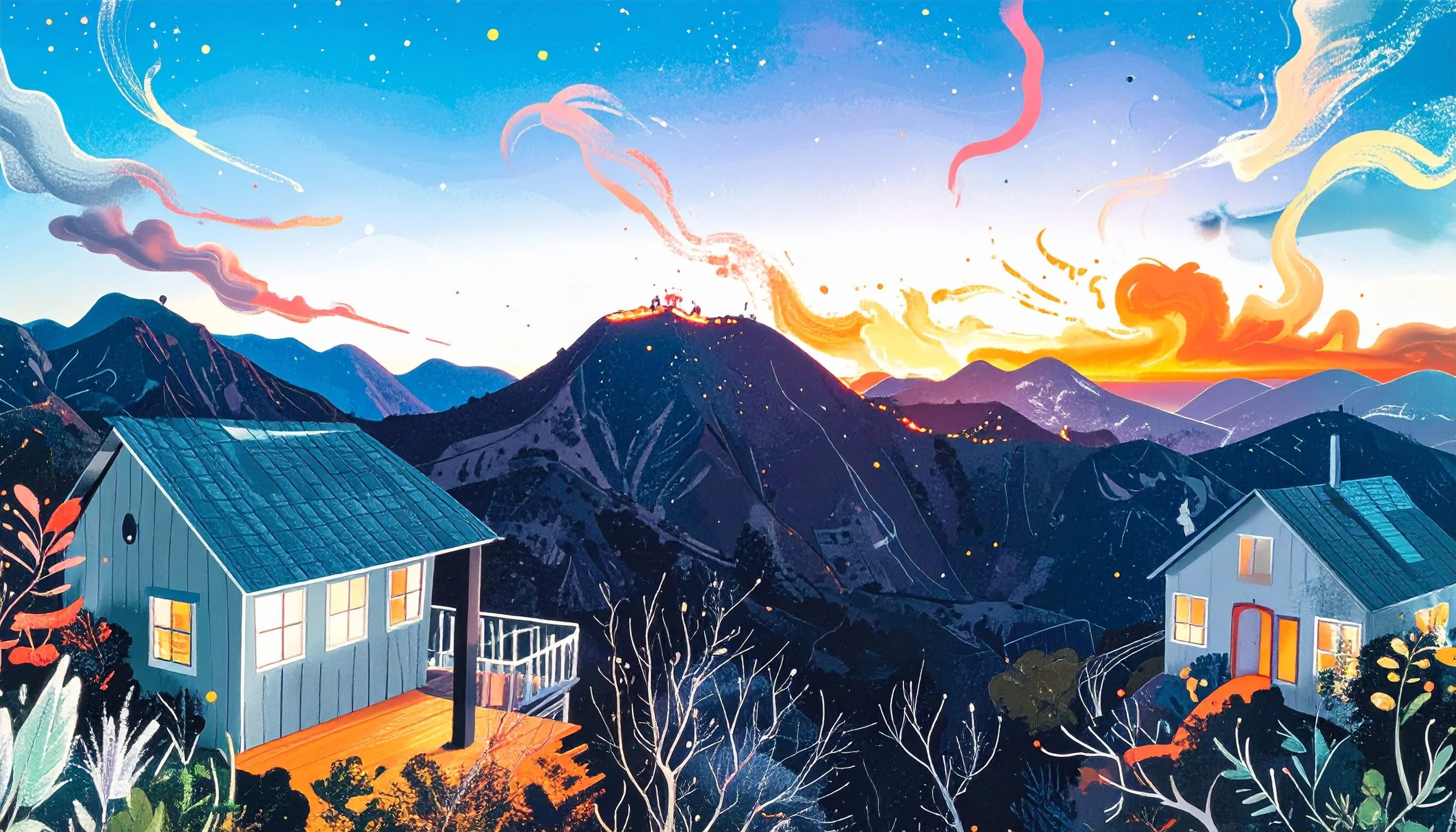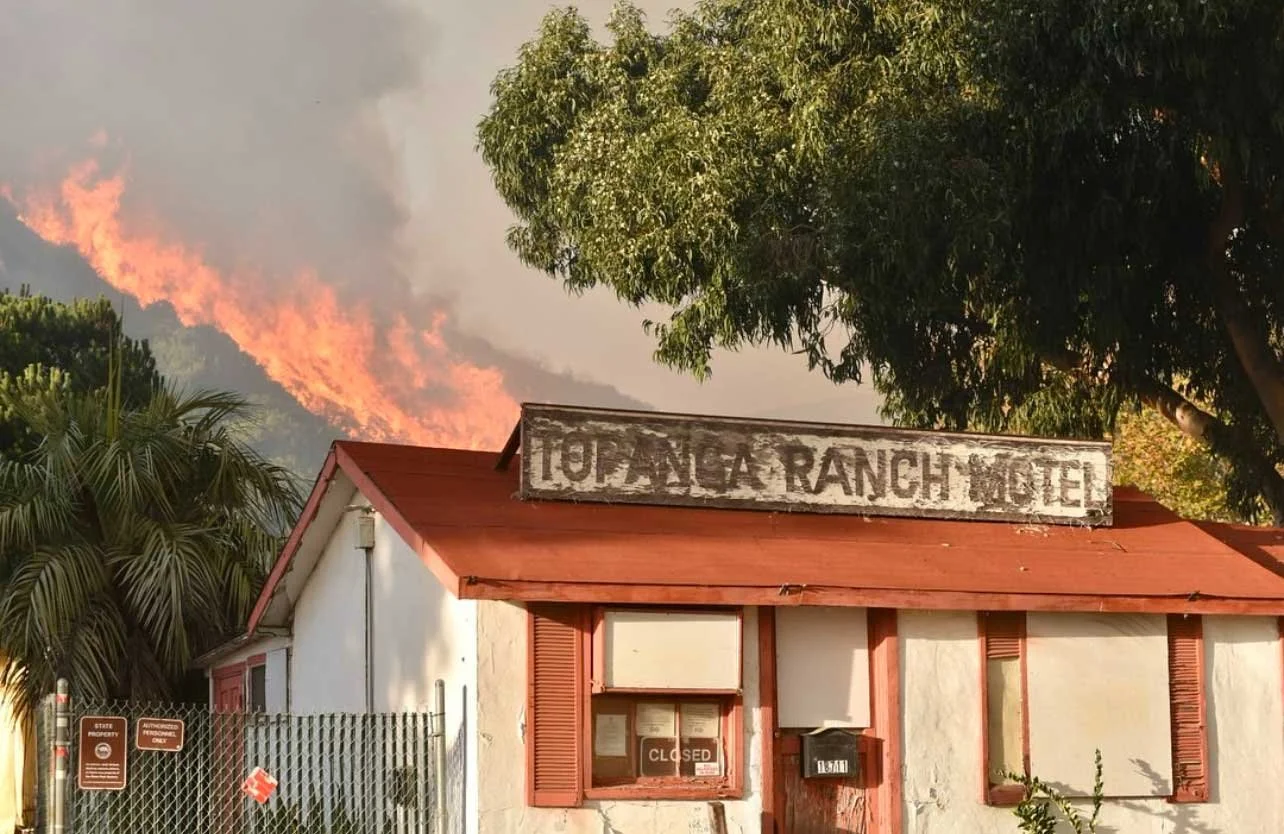Between the Fire and the Mountain
Fire is an elemental agent of change. It is unforgiving and absolute, and we are all in thrall to its brutal, radical release.
This past month, we learned this lesson again with the merciless and ferocious Palisades Fire.
We’ve always half-joked that Topanga Canyon is an ephemeral place of beauty—a hidden town up in the wooded, green Santa Monica Mountains, nestled between the Pacific Palisades and Malibu, peopled by an eclectic mix of ne’er-do-wells, eccentrics, independent thinkers, poets, artists, and surfers. Its beauty is matched only by the knowledge that it exists within a fire zone that could snatch it all away.
Fires are a natural part of the ecosystem here, but they have been suppressed by us not-fire-loving humans, resulting in the beautiful, rolling hills being bushier, greener, and more fuel-heavy than they naturally should be.
As a community, we’ve become a national model for preparing for the inevitable fire that would one day threaten the town. The last time a fire burned in Topanga was in the ’90s, so we all knew we were due. We scraped by year after year, breathing a sigh of relief when the rains finally arrived after another season of dry Santa Ana winds.
But this past month, the bill finally arrived.
The view across from us has changed, but it will heal in time.
We woke up on Tuesday, January 7, knowing there would be severe winds, but we could immediately tell things felt… different. My husband woke up before me at 4:30 a.m. and immediately booked a hotel room, knowing we’d probably lose power (which also means losing cell service and not receiving emergency notices in case of a flare up). This wasn’t our first rodeo, and things felt particularly strange that day, so we both agreed it was a good idea.
At approximately 10:35 a.m., I was wrapping up a client call, and my phone pinged: there was a vegetation fire reported in the Palisades, only one canyon over from us. We’ve dealt with fires in the Palisades before, but this was the worst possible timing, and my heart dropped. I knew the winds were just beginning in what was shaping up to be a red-flag, multi-day severe wind event. This could be bad. Really bad.
When my call ended ten minutes later, I walked into my living room window and witnessed the massive column of smoke already filling up the sky. This wasn’t normal—its growth was exponential. My husband and I looked at each other in shock and agreed: even though we weren’t directly in its path, it was time to go.
We packed quickly, slightly panicky, and reached our hotel in Santa Monica shortly after. The fire was already a monster, and the winds were unlike anything we had experienced outside of a hurricane (of which I’ve been through my fair share). We watched palm trees bend and almost snap, windows shake, and the wind howl through any cracks it could find, bringing ash and smoke along with it.
When fires occur in our mountains, we deeply rely on water and fire retardant drops from helicopters and planes—all of which were rendered unflyable in 100 mph winds. It quickly dawned on us that there would be no stopping the fire’s progression until the winds died down, and we had so much further to go before that could happen. It was going to be a brutal next couple of days.
We stayed the night but were evacuated from that hotel the next evening as well. We found another place nearby before eventually moving up the coast to our third hotel in Oxnard to escape the smoke.
For those unfamiliar with these seasonal, Santa Ana-fueled fires, there’s a bit of a pattern we all know here. The fires start somewhere in the mountains, and the dry, hot winds from the east push them directly out to the ocean. We hoped the firefighters would be able to minimize the damage as much as possible, but we honestly expected that many homes in that specific area of the Palisades would be lost.
We couldn’t imagine how quickly it would escalate.
The iconic Topanga Ranch Motel, originally built in 1929 by William Randolph Hearst, would be one of many places lost to us in the fire.
The fire didn’t just go out to the ocean, it curled up the coast in both directions. Embers traveled everywhere, sparking new fires in other areas of the Palisades. It had become completely uncontrollable. The water system in the Palisades was designed for a handful of houses burning in a cluster—not hundreds. The infrastructure wasn’t built for it, and the three massive water tanks ran dry. In retrospect, it would have taken hundreds of fire engines at full strength to have kept this all in check. It was all too much, too soon, too fast.
This is why the fire curled up PCH and destroyed so many beloved, generations-old restaurants and homes leading into Malibu. This is why it spread throughout the entire mountain system toward Brentwood, Mandeville Canyon, and Encino. This is why it almost took down Topanga Canyon, where we live.
Even with the winds going the opposite direction, fire wants to climb, and the Santa Monica Mountains provide plenty of opportunities for it. On its second night, it started to snake up from the bottom of Topanga Creek, a seasonal, spring-fed creek that begins at the top of Topanga Canyon and empties into the Pacific.
We were keeping a watchful eye on its steady progression when it began to suddenly barrel up the mountain. We were hopeful (“Surely they would manage it”), but then we got awful, shocking news: the fire wasn’t just going to reach Topanga; it was expected to tear through the center of town within the hour.
At that moment, we accepted we had most-likely lost our house.
What made it worse was the lack of news coverage and minimal firefighting resources in Topanga at that moment. Everyone’s focus was understandably on the Palisades, so Topanga mobilized. We’re known as a little hippie town in the mountains, and boy, did we prove it. People called news stations, local radio, 911, the County Supervisor’s office—you name it. We begged for coverage and help.
And then something unbelievable happened. Right outside of town, as it approached the first structure, the fire just… stalled. It stalled long enough for air resources to finally arrive: aerial water drops, fire retardant from massive air tankers, more firefighters. It gave everyone the chance to get a foothold.
The next morning, we woke up, and our house was still there. The fire had come within a thousand feet of our property, but it stood, as did so many others. They threw everything at it and saved the town.
It tried over the next few days to sneak in via Malibu and through the eastern front of the fire. It got close, heartbreakingly destroying several homes at the top of our neighborhood. But again, they stopped its forward progress with endless water and fire retardant drops and dozens of firefighters clearing brush and creating improvised fire roads. The backbreaking work that hundreds of firefighters from all over the country—as well as Canada, Mexico, and Australia—put into keeping us safe is still hard to fully comprehend.
And so, Topanga is safe.
We are humbled and bruised and slowly emerging from the shock of it all, our hearts aching for all of our friends and neighbors who have lost their homes, businesses, animals, and shared spaces (schools, theaters, etc.). Everyone here has been touched directly in some way and witnessing us all lean on each other has only restrengthened our connection to our community.
All in all, we ended up being evacuated for a little under a month, deciding to spend a few weeks overseas at our place in Austria, where my husband is from, so we could have some normalcy and be out of the way as emergency services continued to cut in new fire roads and create further fire containment.
We were granted a reprieve, but we know we’re not special. The fires will come again, one day.
Until then, we are focused on support and healing—rooting in and expressing how grateful we are. We were both lucky and in deep debt to the men and women who strategically positioned themselves between the fire and the town. We will never be able to properly repay them.



